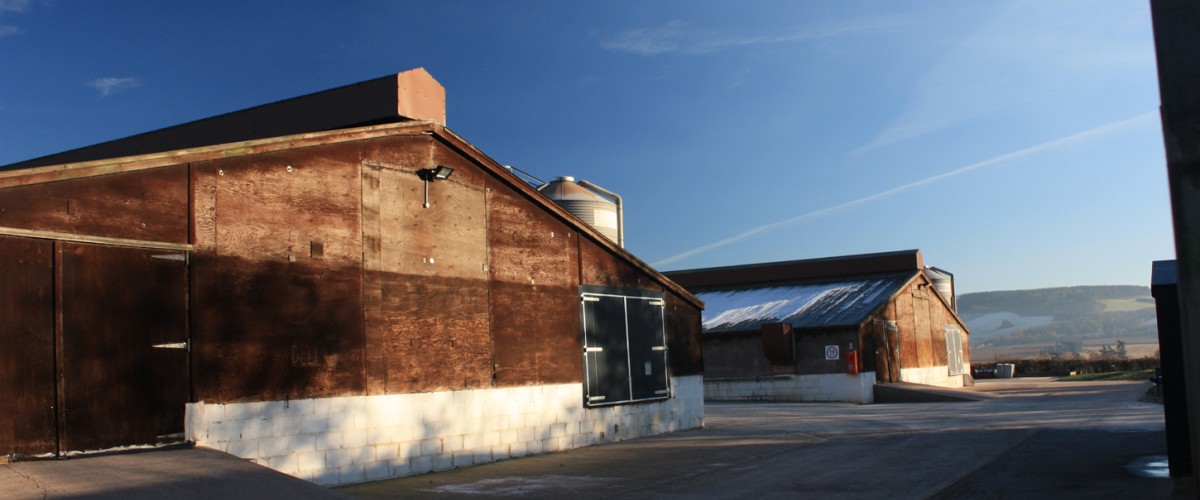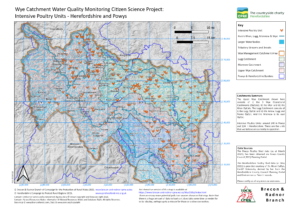Intensive poultry units

Intensive chicken farming is highlighting the tension between cheap food and a safe and healthy environment.
In Herefordshire large corporations are driving the production of cheap food on an industrial scale. The increasing number of giant chicken sheds is having a big impact on the quality of life for local people, soil and water pollution levels and animal welfare.
A lot of chickens…
There’s an estimated 20 million plus chickens1 being farmed in Herefordshire right now – that’s over 100 for every adult and child in the county. These are either farmed for eggs or their meat (broiler chickens). These numbers are increasing all the time and are driven by big businesses.
We’ve teamed up with the Brecon and Radnor branch of our sister organisation CPRW to produce an interactive map showing the density of chicken units in the Wye catchment area. (It may take some time to load up as there’s a lot of data!)
Industry or farming?
The reality of modern egg and chicken production is a long way from traditional images of a few hens pecking around the farmyard. As an example, the global conglomerate Avara (a joint venture between US owned Cargill and Faccenda foods) runs a hatchery at Shobdon in the north of Herefordshire, a factory preparing chicken meat in Hereford and a mill producing chicken food in Allensmore. Farmers own the huge chicken sheds, while Avara employs the drivers and workers who catch the grown birds by their thousands at night. The broiler diet is mostly imported soy beans grown in South America on Cargill’s plantations for which virgin rain forests have been felled2.
The Environment Agency classes intensive chicken units as industrial and the planning system takes account of their huge potential impact on the environment. Any development housing more than 85,000 broilers or 60,000 egg-layers comes within Schedule One of the Environmental Regulations3, the same class as a new airport or nuclear power plant. (An average broiler shed houses 45-50 thousand birds and most applications are for four or more sheds).
But there’s a contradiction in the planning system: because intensive chicken units are judged as farm diversification, there is a presumption that they belong in the countryside.
Manure and water courses
We’re really worried about the hundreds of thousands of tonnes of litter containing manure from chicken units in Herefordshire and surrounding counties. Much of this is spread on fields as fertiliser with the risk that nutrients and toxins get into the rivers, causing pollution. Poultry manure contains more phosphates (which increase water nutrients) than any other farm manure.
The growth in the industry has coincided with a shocking rise in phosphate levels in the River Wye Special Area of Conservation and the River Lugg, a Site of Special Scientific Interest, and their tributaries. The last two summers we’ve seen algal blooms turning the River Wye green and smothering water plants and river beds with sludge. This crisis was highlighted in the well-researched and very informative documentary ‘Rivercide’ presented by George Monbiot.
The intensity of the production process is increasing every year. The industry is producing birds that reach ‘maturity’ sooner, with chickens reaching ‘table-weight’ just 19 days from hatching. This can only increase the amounts of manure produced because there will be many more flocks per year.
Smell
Most people find chicken manure has a very unpleasant smell, largely due to its ammonia content. So local residents living within range find they cannot use their gardens or open their windows; they can find it difficult to sell their houses and are not entitled to compensation. Complaints tend to be dismissed by the authorities.
Planning and IPUs
Planning applications for intensive poultry units are required to consider the most serious impacts – traffic, noise, smell, dust, and pollution. But because these developments are allowed in rural areas in principle, planning authorities are obliged to agree ways of reducing the harm and can refuse permission only if it’s not possible to ‘mitigate’ their harm to the landscape and environment. Mitigate does not mean prevent or avoid, it means reduce – and how much that reduction needs to be is decided by the planning authority.
Because of the large number of documents provided by an applicant, to comment properly takes a lot of time and often needs research into similar applications and decisions. An objection needs to be related to current local and or national planning policies.
Increased traffic from poultry units
The broiler industry adds very high numbers of vehicle movements to Herefordshire’s roads every year. For instance, one 4-shed development can generate up to 3,000 lorry journeys. Eggs are laid on one farm then delivered to a hatchery in another part of the county. Then day-old chicks are delivered to the broiler units on farms across the region where they grow for around four weeks before travelling to Hereford for slaughter and processing. The finished products then move on to their final destination, which may be abroad. Lorries bring food , bedding and other goods onto the farm and remove dead chickens, manure and dirty water.
The taxpayer ultimately pays for the highway improvements and maintenance needed to support all this traffic. Intensive poultry unit buildings don’t fall within business rates and farm vehicles are exempt from road tax.
The future
We’re calling for a change in planning policy to recognise that intensive poultry units are industrial development, with impacts as harmful as other large industries. Because of this they should occupy brownfield land with good transport connections, away from people’s homes and on sites which don’t impact the environment. Basically, not in the open countryside. If poultry units were classified as industrial development Councils could charge business rates on them – at present rate payers are subsidising them.
We want the industry to re-think its model and operate more sustainably by locating all the different processes (egg-laying, hatching, growing, feed production and processing) if not in a single location, at least close to one another.
If you hear of an application in the area and would like our advice, please give us as much notice as possible to allow us to help you prepare a suitable objection.
Email us at: admin@cpreherefordshire.org.uk
- Rivercide documentary https://rivercide.tv/
- https://www.theguardian.com/environment/2020/nov/25/revealed-uk-supermarket-and-fast-food-chicken-linked-to-brazil-deforestation-soy-soya – page accessed 28.09.21
- Town and Country Planning (Environmental Impact Assessment) Regulations 2011 https://www.legislation.gov.uk/uksi/2011/1824/contents/made




